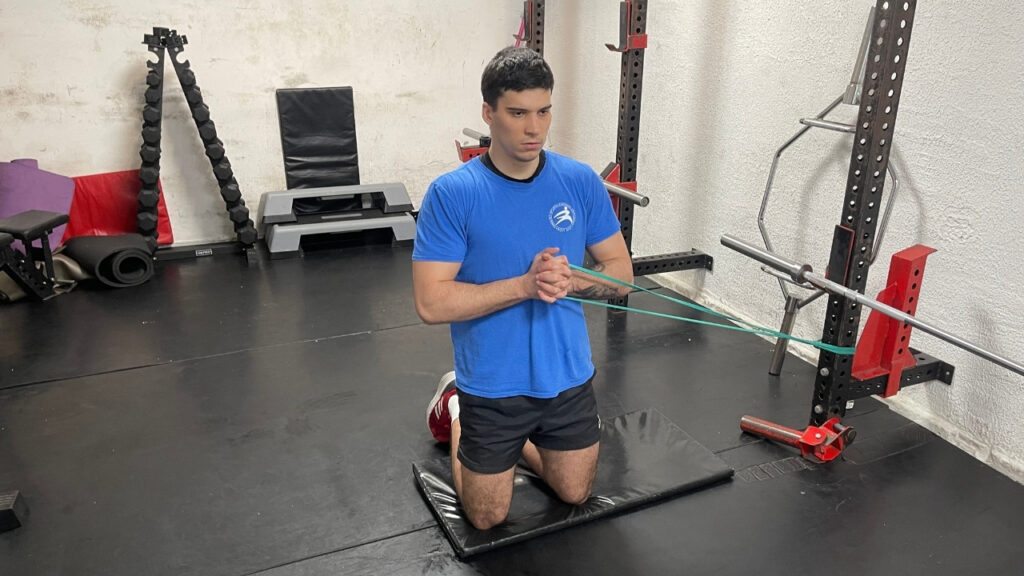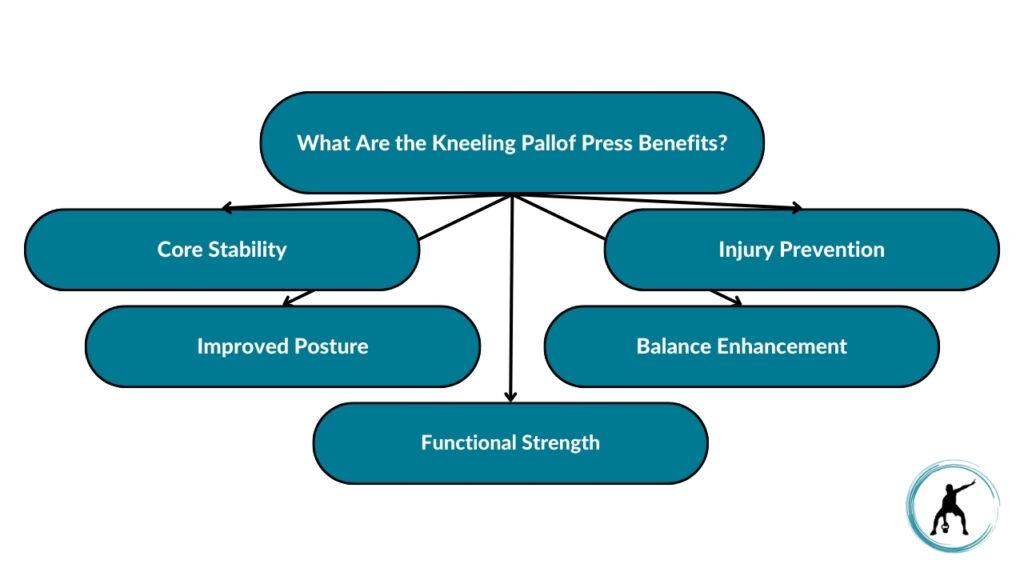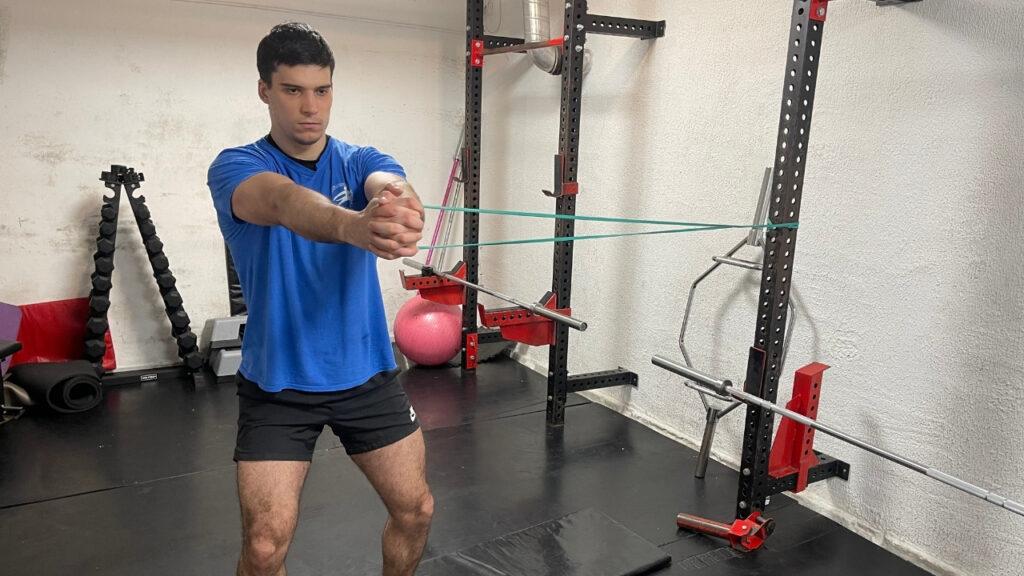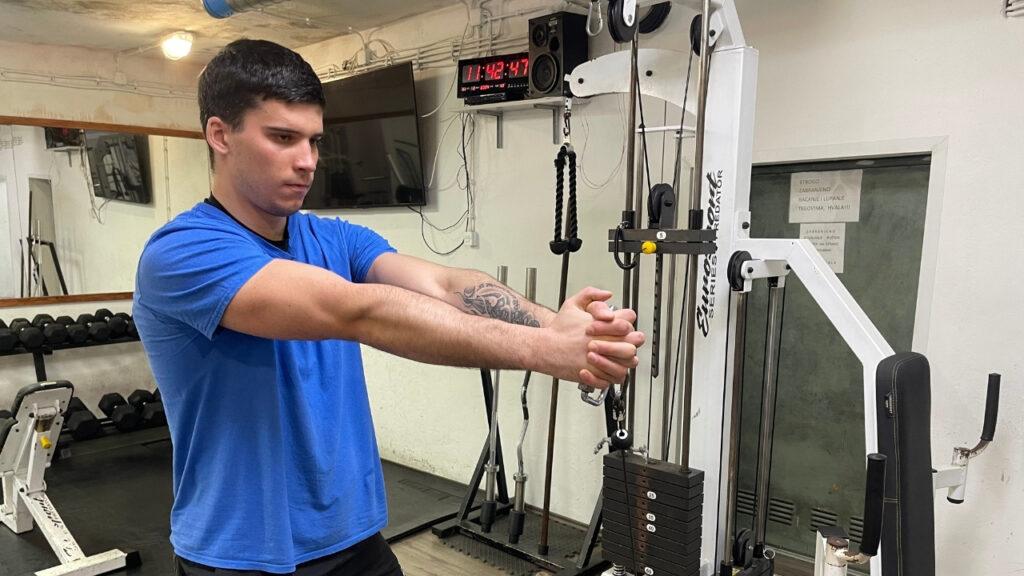The kneeling pallof press is one of the best core exercises for increasing trunk stability and building solid ab strength.
Table of Contents
ToggleChoosing the right exercise for training your core might be a challenge. From simple exercises such as sit-ups that are known to all to some exercise you have never heard of. We all have a preference, and that is totally fine.
Maybe you like training your core while lying, standing, hanging, or hanging upside-down. There are plenty of exercises you will see online if you search for 5 minutes. Many of them don’t even work and are there just for the views.
But the one core exercise that stands out is the kneeling pallof press. To learn how to do a kneeling pallof press, follow the simple and easy step-by-step guide below.
Start Building Your Dream Body Today
Ready to elevate your fitness game without falling into the trap of dull, repetitive routines that just don’t deliver? Imagine sculpting your ideal physique and boosting your health, all while still enjoying life’s pleasures, like those irresistible weekend getaways and your aunt’s legendary cheesecake. With our online fitness and nutrition coaching service, you don’t have to compromise. Dive into a personalized fitness journey that blends perfectly with your lifestyle, not against it. Book your completely free discovery consultation today, and take the first step towards a transformation that doesn’t require giving up the joys of life.

“I was skeptical about online fitness coaching, but Functional Body Savage completely changed my perspective. Vanja and Radomir’s personalized approach and attention to detail have helped me achieve goals I never thought possible. I’m stronger, more confident, and grateful for their guidance.”
Emily Thompson, San Francisco, CA
Learn More About Our Online Coaching ServiceQuick Summary
- To do a kneeling pallof press, assume a kneeling position with a resistance band in your hands and push in front of your chest to create tension and activate your core muscles.
- The kneeling pallof press is a core exercise that targets various muscles such as the obliques, abdominals, and hip muscles.
- It increases core stability, improves posture, and may prevent injuries.
- There are many variations of the pallof press, like standing and half kneeling, so it is both beginner and veteran-friendly.
How to Do a Kneeling Pallof Press
Here is how to do a kneeling pallof press variation.
Step One — Assume the Starting Position
Wrap the resistance band around the squat pole or some other sturdy object in the gym. You should place the resistance band at the height level of your chest when in a kneeling position. Assume a kneeling position with your back straight and core engaged. Hold a resistance band with both hands, positioning it at chest level.

Pro Tip: Focus on maintaining proper alignment by keeping your core engaged and shoulders relaxed while kneeling. This ensures a strong foundation for the exercise.
Step Two — Press the Band Away From Your Chest
Press the band away from your chest, extending your arms fully while maintaining a stable core and upright posture. Feel the resistance in your chest and shoulders.

Pro Tip: During the press, exhale as you extend your arms, focusing on controlled movements. Keep your chest open and engage your chest and shoulder muscles to maximize the effectiveness of the exercise.
Step Three — Return the Band to the Starting Position
Slowly return the band to the starting position, controlling the movement to engage your muscles throughout. Repeat the exercise for a complete set, focusing on proper form and controlled motions.

Pro Tip: When returning the band to the starting position, inhale and resist the urge to rush the movement. Control the descending phase of the exercise to work the muscles eccentrically, promoting strength and stability.
Kneeling Pallof Press Muscles Worked
Kneeling pallof press primarily targets your abdominals, obliques, and core stiffness.
It secondarily targets transverse abdominis, scapular stabilizers, gluteals, and rectus abdominis.
Pallof Press Kneeling vs Standing
The difference between kneeling and standing pallof press, besides the obvious difference in position of your body, is the difficulty.
Generally speaking, standing pallof press tends to be harder for many people because it requires stability in a more upright position, engaging a broader range of muscles to resist rotational forces. The kneeling pallof press may be considered slightly more stable due to the grounded position.
However, the perceived difficulty can also be influenced by factors such as overall core strength, balance, and experience with the exercises. It’s recommended to incorporate both variations into your routine to target the core muscles from different angles and enhance overall stability.
What Are the Kneeling Pallof Press Benefits?
Down below are the benefits of the kneeling pallof press that stand out.

Core Stability
The kneeling pallof press is an effective exercise for enhancing core stability. It targets the muscles of the core, including the rectus abdominis, obliques, and transverse abdominis, promoting better overall core strength and stability.
Improved Posture
By engaging the core muscles and promoting spinal alignment, the kneeling pallof press contributes to improved posture. Strengthening the core helps counteract the effects of sedentary lifestyles and promotes a more upright and aligned body position.
Functional Strength
This exercise not only strengthens the core but also enhances functional strength. The resistance provided by the cable during the pallof press replicates real-life movements, making it a functional exercise that translates into improved strength for daily activities.
One of the studies from the PubMed website found that a 12-week Functional Strength Training (FST) program significantly improved functional movement, flexibility, and physical performance in middle and high school students compared to traditional physical education classes [1].
Balance Enhancement
The kneeling pallof press requires stability, helping improve overall balance. The engagement of core muscles and maintenance of a controlled position during the exercise contributes to better balance, which is crucial for various physical activities and injury prevention.
Injury Prevention
The emphasis on core stability in the kneeling pallof press can aid in injury prevention. A strong and stable core supports the spine and reduces the risk of lower back injuries, making this exercise valuable for overall injury prevention.
What Are the Best Tips for Performing a Kneeling Pallof Press?
Performing a kneeling pallof press effectively involves specific techniques to maximize its benefits. Here are some essential tips to help you perform the kneeling pallof press.

Establish a Strong Kneeling Foundation
Begin by kneeling with a stable base. Ensure your knees are directly under your hips and your spine is neutral. This foundational stability is necessary for the effective engagement of core muscles.
Secure Band to a Stable Anchor Point
Attach the resistance band to a secure anchor point at chest height. This ensures consistent resistance throughout the movement, providing optimal muscle activation. If you are looking for the perfect resistance band for your home workouts, check some of the articles below:
Control the Pressing Motion
Execute the pallof press with controlled movements. Extend your arms fully in front of you and retract them back, focusing on engaging your core throughout. This controlled motion maximizes muscle activation and minimizes the risk of injury.
Sync Breathing With Movement
Coordinate your breathing with the pressing motion. Inhale as you extend your arms and exhale as you bring them back towards your chest. This synchronization helps maintain stability and supports the engagement of core muscles.
What Are the Most Common Mistakes During Kneeling Pallof Presses?
Making mistakes while training is very common. Fighting against them will optimize muscle strengthening and growth. Here are some of the most common mistakes people make while doing a kneeling pallof press.

Inadequate Core Engagement
Not activating your core while kneeling is the first mistake when doing the pallof press. Make sure your core is properly engaged to stabilize your body and target the intended muscle groups.
Unstable Midline
Maintaining a stable midline is essential for the success of kneeling pallof presses. Any deviation from a straight and controlled position compromises the exercise’s purpose. Focus on a steady midline to optimize results.
Lack of Gradual Progression
Advancing too quickly in resistance or intensity can lead to bad form. Gradual progression is key to mastering kneeling pallof presses, allowing your muscles to adapt and reducing the risk of injury.
Poor Eye Focus
Overlooking the importance of eye focus can impact your balance and form during the exercise. Keep your gaze forward, aligning with the movement, to enhance concentration and overall performance.
Kneeling Pallof Press Variations
Here are some variations of the pall of press that might work better for you.
Half Kneeling Pallof Press
The half-kneeling version increases the demand on your core and hip stability, making it generally more challenging than the standard kneeling pallof press. It also engages muscles differently, incorporating more hip flexor and quadriceps activation.

Steps:
- Start in a half-kneeling position with one knee on the ground and the opposite foot planted firmly.
- Hold a resistance band or cable handle at chest height; arms extended in front of you.
- Maintain a strong core and straight posture as you press the resistance away from your chest, resisting rotation.
- Hold the extended position briefly, then bring the resistance back to your chest in a controlled manner.
- Switch legs and repeat the exercise on the other side.
Pro Tip: Engage your core throughout the movement, and focus on resisting any rotation to target the obliques and improve overall core strength effectively.
Standing Pallof Press
This variation of the exercise, the standing pallof press, may engage lower body muscles for stability, while the kneeling pallof press may offer a different challenge to the core muscles.

Steps:
- Stand with your feet shoulder-width apart and hold a resistance band or cable handle at chest height, arms extended in front of you.
- Engage your core muscles and maintain a straight posture throughout the exercise.
- Press the resistance away from your chest, resisting any rotation or lateral movement.
- Hold the extended position for a brief moment, focusing on stability.
- Slowly bring the resistance back towards your chest in a controlled manner, maintaining control over the movement.
Pro Tip: Make sure you breathe properly throughout the exercise, exhaling as you press the resistance away and inhaling as you bring it back. Also, pay attention to your body alignment and avoid any compensatory movements.
Pallof Press With Rotation
The pallof press with rotation adds a dynamic element to the exercise, engaging rotational muscles in addition to core stability.

Steps:
- Begin in a standing position with feet shoulder-width apart, holding a resistance band or cable handle at chest height.
- Press the resistance away from your chest, resisting rotation as you extend your arms.
- Incorporate a controlled rotation of your torso away from the anchor point while keeping your hips facing forward.
- Hold the rotated position for a moment, emphasizing stability and engagement of oblique muscles.
- Slowly bring the resistance back toward your chest, reversing the rotation in a controlled manner.
- Make sure to engage your core and maintain a straight posture throughout the exercise.
Pro Tip: Coordinate your breathing, exhaling during the press and rotation and inhaling as you return to the starting position. Focus on maintaining proper form and avoiding any jerky movements for optimal effectiveness.
Kneeling Pallof Press Alternative Exercises
Here are a few alternative exercises for kneeling pallof press you can use instead.
Standing Cable Anti-rotation Press
This exercise emphasizes core stability and anti-rotation, engaging your abdominal muscles.

Steps:
- Stand with feet shoulder-width apart, facing away from the cable machine at the 90-degree angle.
- Hold the cable handle with both hands; arms extended in front of you.
- Maintain a stable stance and resist rotation as you press the cable straight out.
- Bring the handle back to the starting position with controlled movement.
- Keep your core tight throughout the exercise to resist rotational forces.
Pro Tip: Focus on preventing any twisting or turning of your torso, emphasizing control and stability in your core muscles.
Woodchop Exercise
This movement targets various muscle groups, enhancing both strength and coordination.

Steps:
- Start in a standing position with your feet shoulder-width apart, holding a weight or medicine ball with both hands.
- Begin the motion by reaching down and across your body towards the outside of your front foot.
- As you stand back up, simultaneously raise the weight diagonally across your body, finishing the movement above your opposite shoulder.
- Engage your core and pivot your back foot as you perform the motion.
- Control the descent of the weight back to the starting position.
Pro Tip: Execute the exercise with a smooth, controlled motion, emphasizing the engagement of your core and the rotation of your torso.
Plank With Alternating Arm Lift
This plank variation enhances core strength and stability by incorporating unilateral arm movements.

Steps:
- Begin in a plank position with your hands directly beneath your shoulders and your body forming a straight line from head to heels.
- Lift one arm off the ground, extending it forward while maintaining a stable plank position.
- Hold the lifted arm for a moment, ensuring your body stays steady without rotating.
- Lower the lifted arm back to the ground and repeat the same movement with the opposite arm.
- Continue alternating arms, focusing on maintaining a strong plank position throughout.
Pro Tip: Keep your hips and shoulders parallel to the ground, and engage your core to prevent excessive twisting. This exercise not only targets your core but also improves shoulder stability and strength.
Bird Dog Exercise
The bird dog is an excellent exercise for strengthening the core muscles and improving balance.

Steps:
- Start on your hands and knees in a tabletop position, with your wrists directly under your shoulders and your knees under your hips.
- Simultaneously extend your right arm forward and your left leg backward, keeping them parallel to the ground.
- Focus on keeping your hips and shoulders square to the ground, avoiding any rotation.
- Hold the extended position for a moment, engaging your core for stability.
- Bring your elbow and knee back to the starting position with control.
- Repeat the movement on the opposite side, extending your left arm and right leg.
Pro Tip: Ensure a straight line from your fingertips to your toes during the extension, and concentrate on maintaining balance and stability throughout the exercise.
Russian Twists With Weight
This exercise targets the obliques, enhancing core strength and rotational stability.

Steps:
- Sit on the floor with your knees bent, feet flat on the ground, and your back leaning slightly backward.
- Hold a weight or medicine ball with both hands and arms extended in front of you.
- Lift your feet a few inches off the ground, balancing on your sit bones.
- Twist your torso to one side, bringing the weight beside your hip.
- Return to the center and then twist to the opposite side, moving the weight across your body.
- Continue alternating sides in a controlled, rhythmic motion.
Pro Tip: Engage your core throughout the exercise and control the movement to prevent momentum. This adds an extra challenge to your obliques and promotes a strong, stable core.
FAQs
Is Pallof Press the Best Core Exercise?
The pallof press is one of the best core exercises out there since it trains your core muscles based on their true function. The true function of core muscles is to prevent movement, which doesn’t mean you shouldn’t also perform flexion, lateral flexion, or rotation of your trunk.
Is Pallof Press Better Than Plank?
The pallof press might be better than a plank, especially if you have wrist problems and pain. Both exercises are excellent for exercising your core stability and strength through different approaches, starting positions, and stabilization requirements.
Can You Do Pallof Press Every Day?
You shouldn’t do pallof press every day because, as with most muscle groups, the core muscles need appropriate recovery time. It is during this recovery time that the muscles actually repair themselves and grow.
How Long Should You Hold Pallof Press?
You should hold the pallof press for 5-10 seconds.
Does Pallof Press Build Abs?
The pallof press builds strong and functional abs that give stability to your body.
Wrapping Up
Kneeling pallof press is a core exercise that works obliques, abdominals, and core stiffness, strengthens them, and prepares your core for any activities you might do.
Whether you are looking for another core exercise to add to your training list or a replacement for an old core exercise, the kneeling pallof press won’t disappoint you.
Make sure to train them consistently with the correct form to get the benefits, just like with any other exercise.
Start Building Your Dream Body Today
Ready to elevate your fitness game without falling into the trap of dull, repetitive routines that just don’t deliver? Imagine sculpting your ideal physique and boosting your health, all while still enjoying life’s pleasures, like those irresistible weekend getaways and your aunt’s legendary cheesecake. With our online fitness and nutrition coaching service, you don’t have to compromise. Dive into a personalized fitness journey that blends perfectly with your lifestyle, not against it. Book your completely free discovery consultation today, and take the first step towards a transformation that doesn’t require giving up the joys of life.

“I was skeptical about online fitness coaching, but Functional Body Savage completely changed my perspective. Vanja and Radomir’s personalized approach and attention to detail have helped me achieve goals I never thought possible. I’m stronger, more confident, and grateful for their guidance.”
Emily Thompson, San Francisco, CA
Learn More About Our Online Coaching ServiceReferences:
- Liao T, Duhig SJ, Du G, Luo B, Wang YT. The Effect of a Functional Strength Training Intervention on Movement Quality and Physical Fitness in Adolescents. Percept Mot Skills. 2022;129(1):176-194. doi:10.1177/00315125211056865







